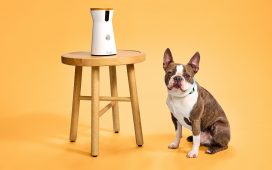CHICAGO — Color does not have flavor, yet consumers associate certain flavors with colors. A red carbonated water should not taste like lemon, while a yellow one would be thought to have citrus, maybe sour or tart notes.
Because we eat and drink with our eyes, color is important. And not just color, but the shade of a color and the type of product.
In beverages, brown is a strange color. It is not associated with any fruit or vegetable, except maybe overripe bananas or oxidized greens (coffee is a fruit, technically). Different flavors and types of beverages are associated with brown. The obvious are cola, coffee, tea and chocolate milk, as well as beer and some spirits. And, while such beverages as spicy tomato juice and pumpkin spice latte are not brown, the hue may be added — directly or indirectly through the blending of other colors — to provide an element of richness, maybe even the look of the savory, delicious taste of umami.
“Aside from traditional colas and sodas, brewed teas and tea-based beverages benefit from the addition of brown colors,” said Meghan Fox, marketing specialist, Sensient Food Colors, St. Louis. “The addition of the brown hues conveys the shades of more traditional brewed teas in products that may not go through a tealeaf brewing process. Using brown colors also allows the manufacturer to standardize the color of their end product to reduce shade-to-shade variability.”
Because color is an assessment of quality, inherently brown beverages often benefit from the addition of brown color to offset color loss that may occur during shelf life from exposure to the environment. It also helps provide consistency of color from batch to batch, as in the case of a ready-to-drink coffee latte packaged in a glass bottle.
First there was caramel
Formulators seeking to add brown color to beverages typically have relied on caramel colors, which are produced through the controlled heat treatment or cooking of carbohydrates, a process known as caramelization.
“The carbonated soft drinks industry has been using caramel color since the 19th century, and it is the most widely used colorant in the soft drink industry,” said Brian Sethness, executive vice-president of sales and marketing, Sethness Roquette, Skokie, Ill. “Because of the low pH of most carbonated beverages, Class IV caramel colors are commonly used because of their acid stability. In addition to providing excellent reddish to brown hues, caramel color can enhance the foaming characteristics, mouthfeel and flavor of soft drinks.”
There are four classes of caramel color, based on production method. Some consumers may be concerned with the chemical 4-Methylimidazole (4-Mel), which forms during the production of Class III and Class IV caramel colors. While there has been an industry shift to use Class I caramel color, also known as plain caramel, in efforts to eliminate 4-Mel, all classes of caramel color are labeled “caramel color” or “caramel” on ingredient statements. That is everywhere except in California.
As of Aug. 30, 2018, Proposition 65 in California has been fully implemented. The law requires companies to call out specific names of potentially harmful chemicals, such as 4-Mel, and add a warning symbol on the product if they exceed acceptable levels. For 4-Mel, it is 29 micrograms per day.
To assist with not exceeding the limit, Food Chemical Codex (F.C.C.), an international food safety organization, recently established a new maximum limit of 125 parts per million (p.p.m.) of detectable 4-Mel in caramel color. The limit went into effect on Dec. 1, 2018, and did require some caramel colors to be pulled from the U.S. market.
Suppliers such as Sethness Roquette anticipated the revision. During the past two years the company developed replacement caramel colors for 12 products in its portfolio of more than 80 caramel colors that it can no longer manufacture due to the F.C.C.’s lower 4-Mel limits.
“The goal was to have replacement caramel colors that were virtually identical to — with the exception of the lower 4-Mel value — the colors being discontinued,” Mr. Sethness said. “We have been very successful in achieving that goal, and these caramel colors are readily available.”
Suppliers now also offer Non-G.M.O. Project verified caramel color options to address consumer concerns with genetically modified ingredients. This is because the most common source of carbohydrate for making caramel colors comes from corn, a crop that has been mostly genetically modified.
Concerns over 4-Mel have some beverage formulators switching to Class I caramels, burnt sugars and fruit- and vegetable-based browns.
“Unfortunately, many of these products don’t hit the same darkness and hue level required by product developers,” said Bryan Aviles, senior innovation scientist, DDW, The Color House, Louisville, Ky. “Our new specialty dark Class I caramels come very close to replacing the darkness and successfully matching the hue. The cooking processes developed to create these new browns don’t require the chemicals or processing agents of traditional methods.”
When adding any color to a beverage, formulators may encounter stability issues.
“The most common problem when incorporating caramel colors is the formation of a precipitate, which can range from a haze to settled solids,” Mr. Sethness said. “The precipitate may form immediately or over time, with slowly forming precipitates being the most difficult to deal with.”
The four classes of caramel color each have a distinct ionic charge, making them more or less applicable for specific beverage attributes, as they may interact with other ingredients. Dairy drinks, for example, require color that interacts well with milk proteins and remains in suspension. It is critical to match the ionic charge of the caramel with that of the other ingredients in the dairy product. Beverages containing apple juice, which often is added as a natural source of sweetness, also may experience the formation of precipitates.
“Apple juice concentrates can vary in interactions with caramel colors,” Mr. Sethness said. “A formulation may require a different class of caramel color to avoid sediment on the bottom.
“Class I caramel colors tend to fade in color. One way to combat the fading is to use ultraviolet-filtering bottles. Class I caramel colors also may not work in any colas containing phosphoric acid, but can potentially be utilized in beverages containing citric acid.”
In addition to providing brown hues, caramel colors may offer additional benefits. In soft drink concentrates they exert an emulsifying effect on flavor oils. Their dark hue may provide some light protection to flavoring components, slowing their rate of light oxidation in clear containers.
Plant-derived options
An array of fruit- and vegetable-based browns are available to beverage manufacturers, with more in the works. DDW is preparing to launch a rich anthocyanin brown color from a vegetable source.
“It performs great in dairy and protein-enhanced beverages, imparting chocolate-like caramel hues,” Mr. Aviles said. “It is gently extracted and concentrated.”
GNT USA, Inc., Tarrytown, N.Y., provides brown solutions that are mixtures of fruits and vegetables. The colors are alternatives to traditional caramel colors and are suitable for all beverage applications.
Diana Foods Ltd., United Kingdom, offers a brown color based on malt extract, purple carrot and hibiscus. It provides a “cola brown” color that may be used to replace caramel color, said Phillip Cook, research and development platform leader for colors.
A 2019 consumer survey conducted by Sensient indicated more than 80% of consumers are concerned on some level about the inclusion of caramel coloring in their beverages. Manufacturers seeking botanical alternatives to caramel colors may look to Sensient, which has a range of options.
“One option is a very cost-effective, perfect shade match to Class I and Class II caramel colors that can be labeled as fruit juice,” said Alexandra Sirosky, technical service manager — beverage and dairy at Sensient. “It is a heat-, light- and pH-stable ingredient and provides an excellent base foundation for darker solutions. Blends may achieve similar shades to Class III and IV caramel colors.
“Achieving a brown shade from botanical color sources in an acidic beverage base has been a challenge for the beverage industry. Traditionally, to achieve a botanically based brown shade, you need a yellow, blue and red component.”
The botanical blue component in this type of beverage solution has been an industry-wide challenge. This is because low pH-stable sky-blue botanical color still does not exist, Ms. Sirosky said.
In acidic beverage systems, the brown fruit juice color is a more cost-effective option than traditional three-component brown blends, which has made it more attractive to formulators looking to simplify their labels.
“It achieves a golden brown alone or darker browns when used in combination with other botanical color components,” Ms. Sirosky said.
Regardless of color selection, beverage marketers must remember that the Food and Drug Administration does not consider any color added to a food as being natural, unless the color is natural to the product itself, such as strawberry extract boosting the red color of strawberries in a strawberry smoothie. Therefore, when flagging the use of clean colors in a formulation, it is more common to use label claims such as “free from synthetic colors” or “colored with vegetable juice” rather than “all natural.”






